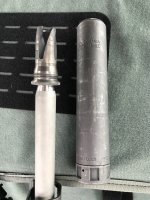I have a few - one that was AR-specific (before those were stolen from us last year) which is now in search of a new host rifle, a 33LM ratchet-lock model, and a light direct-thread model for hunting, as well as a ratchet-lock model, for longer strings of fire, currently on order.
They're spendy (about NZ$1000 / US$660 for 556 and 762 models, and NZ$1500-1700 / US$995-1125 for the 338 models), but amazing.
Oceania Defence not only do titanium, but also Iconel. They're nitrided to provide a yield strength of about 1000 MPA, depending on the model.
They have both direct-thread and ratchet-locking models that mate to a muzzlebrake or a spiral shaped brake/flashider design.
The NZ hunting magazine Rod & Rifle did a fairly extensive test of suppressors available on the NZ market in their Oct/Nov 2017 issue, which is worth tracking down whether you're in NZ or elsewhere - while most manufacturers' models might not be available outside of NZ, the data provides some interesting baselines to compare designs in other countries. (Their website is
www.rodandrifle.co.nz)
For example, the Oceania Defense Alpine Hunter used in the test weighed just 155 grams / 5.47 oz, yet provided 24.38 dB reduction (the current Alpine Hunter in 762 weighs 165 gr / 5.82 oz.) This was the best weight to dB reduction out of 31 models tested.
Folks here would more likely be interested in the ratchet-lock models, which are rated for more sustained rates of fire. In the magazine's test, the OD Ratchet Lock model tested weighed just 250 grams / 8.82 oz, yet had a dB reduction of 29.4 ... most of the comparison models that had a similar dB reduction weighed significantly more.
Oceania Defense's website says they're exploring options of their cans being available in the US.
Overall, the price is hard to justify ... my take is that they shine in backpack hunting for pack weight reduction; defensive carbine for keeping the muzzle light for fast transitions; and competition or DM/S use that requires a lot of field carrying.
For bench-based, or more static comps, then there are options that provide about 70-100% of the functionality for perhaps 50-70% of the cost, but for 30-100% more weight (these are rough figures, and depends what you're looking for, of course).
The website is worth a read just to get a sense for the design, testing, and results ... they're definitely doing cutting-edge stuff.


